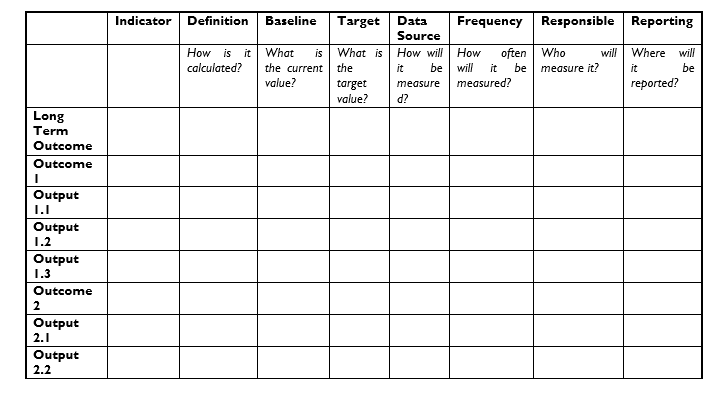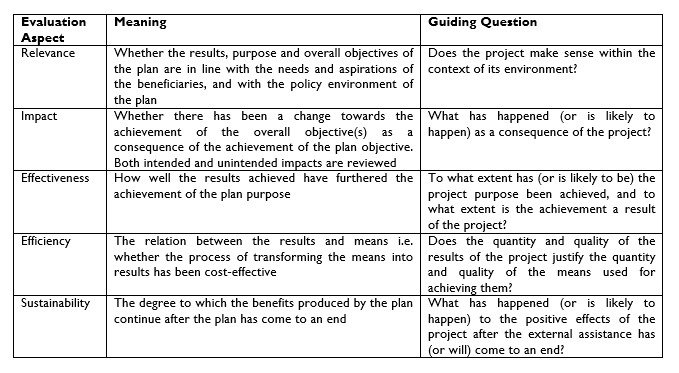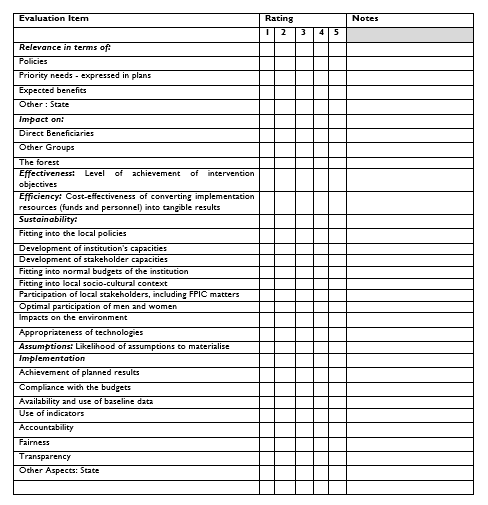¶ Monitoring and Evaluation
¶ Monitoring Responsible Forest Management
Monitoring refers to continuous assessment of an intervention and its environment with regard to the planned objectives, results, activities and means. It enables a FP to review progress and to propose action to be taken in order to achieve the objectives. Monitoring identifies actual or potential successes or failures as early as possible, and thus facilitates timely adjustments to the operations.
Accountability to the public for the forest resources government holds in trust for all Ugandans is a fundamental tenet of forest governance, and thus, RFM. The public, and those who contribute to the management of forests (government, companies, communities, individuals, etc.) tend to place more confidence in the FMI when the achievements are demonstrated by external assessors/ auditors. In practice, this calls for periodic external monitoring of forest management activities.
Instruction 538: There are two important monitoring aspects of RFM that need to be assessed separately although their results complement each other: Forest Governance Assessment using internationally agreed indicators, and forest management audits, which use the internationally approved Uganda NFSS. Thus, Government FMIs shall:
(i) Use formally issued forest governance assessment indicators to track progress in implementing good forest governance. Annex 18 presents a set of questions that may be adapted to specific situations
(ii) Use the NFSS to audit forest management as a means of establishing the extent to which RFM is being achieved. This need not be for purposes of certification by FSC accredited certification bodies
(iii) Conduct both assessments annually for some of the indicators, but full assessment exercises shall be carried out at least once every three years.
(iv) Conduct both assessments through entities that are external to the FMI. The entities shall be required to be unbiased and yet professional in undertaking the assessment. To this end, the government institutions shall procure the services of the external entities through normal PPDA procurement procedures.
Instruction 539: The two assessments shall:
• Be the main means of assessing forestry sector performance;
• Contribute to the preparation of the State of Forests in Uganda, which is required by Section 54 of the Forestry Act;
• Be used as source material for conducting annual staff performance appraisals as required by the Uganda Public Service Standing Orders.
• Inform the preparation of forestry strategic and annual plans, and management activities.
¶ Monitoring Plans
Strategic Plans, DFDPs and FMPs normally have monitoring and evaluation plans that are part and parcel of these instruments. FMIs shall ensure that these monitoring and evaluation plans are rigorously followed in assessing progress in implementation of activities and achieving the objectives of forest management therein. A typical Monitoring and Evaluation Framework is given in Table 17.
Table 17: An Example of a Monitoring and Evaluation Framework

The framework may be modified according to the structure of the specific plan. For example, some institutions may choose to structure their plans using Long-term Objective/ Goal, Strategic Objectives, Results/ Outputs
Instruction 540: Design of a project specific monitoring system is essential during the formulation or early implementation phase of forestry plans and programmes. The design shall take into account:
(i) Setting of specific, measurable, achievable, realistic, and time bound objectives/outputs/results, and assumptions for which indicators are defined.
(ii) For the selected set of indicators, sources of verification are established and provisions made for collecting data and managing records.
(iii) If external statistical information is used, institutional arrangements for gathering, analysing and reporting data are agreed with local statistics offices e.g. URA data on taxes paid.
For purposes of reporting by communities, a simplified version should be used (with modifications depending on the forestry situation in the local area.
¶ Evaluation Plans
Evaluation is a systematic and objective assessment of the design, implementation and outcome of an on-going or completed intervention. The general issues to be evaluated are relevance, impact, effectiveness, efficiency and sustainability[1] . Accordingly, OECD suggests the following basic questions to be asked for each evaluation aspect:

Instruction 541: Evaluation exercises shall be designed and conducted, taking into account the OECD framework summarised above. Below is a checklist that may be used during annual evaluation of performance
Institution/ Unit: ……………………………………………………
Intervention being evaluated: ……………………………………………………
| Type of evaluation: | Basleine | | | Medium Term | | | | Final |
|-----|-----|
Rating on a scale of 1-5: 1 = Very Low; 2 = Low; 3 = Medium; 4 = High; 5 = Very High

Adapted from: OECD Guidelines for Programme Design, Monitoring and Evaluation – Annex 4
¶ Preparation of Forest Management Reports
Reporting is a key component of monitoring activities associated with management plans or District Forest Development Plans. Each FMI will normally have reporting procedures regarding who submits which report to who. The reports are instrumental in facilitating prompt decision making at various levels, and as sources for verification in the larger Monitoring and Evaluation exercises.
Some of the reports will be regular periodic reports (e.g. monthly, quarterly, or/and annually), depending on the established procedures of each FMI. Others will reports on specific situations like field inspection trips, situations on encroachment in a given forest reserve, status of a given water catchment area, etc.
Instruction 542: Where the FMIs have reporting templates, these shall be used, but for purposes of simplifying reporting and generating factual information that is useful for decision making, the following templates should be used, but with modifications, as appropriate for each FMI and reporting needs.
¶ Regular Reporting Template for Use at Forest Management Unit and Community Level
Instruction 543: This template shall be used for monthly, quarterly, and annual reports, as appropriate for each FMI
Addressed to: ……………………………………………………………………………………………………………………………..
(E.g. Chief Administrative Officer/ Terego District)
Name of FMU/ Community Group …………………………………………………………………………………………….
Reporting Period ………………………………………………………....................................................................

Narrative
This section shall be used to highlight key issues in the performance indicators, including reasons for major achievements or constraints, and the proposed actions associated with the constraints
Signed:
Name ………………………………………………………. Title ……………………………………………. Date …………………
Cc …………………………………………………………………….
Cc ………………………………………………………………………
Cc ………………………………………………………………………
¶ Reporting Template for Situational Reports
Instruction 544: This template shall be used for preparation of field supervision reports and reports on specific events
Name of FMU/ Community Group …………………………………………………………………………………………….
Situation being reported on ……………………………………………………………………………………………………...
(E.g. Inspection Trip to Kasyoha Sector, South West Range
Objectives of the Event Leading to this report
Why this report?
The people met and consulted
Contact details in an annex if the people are many (say more than 10)
Target Areas and Key Activities and Observations in each Area
Including a summary of any data collected and maps (by GPS or sketch maps)
Key Conclusions and Proposals for Action and by Who
Annexes
E.g. details of people met, detailed data collected and maps if they cannot be included in the main body of the report
¶ Reporting For Specialised Purposes
Instruction 545: These kinds of reports may be for formal studies, research work, mid-term evaluations, carbon reporting, etc. Reporting in such situations shall follow the formats established by specific institutions for those specific purposes.
OECD Guidelines for Programme Design, Monitoring and Evaluation:
https://www.oecd.org/derec/finland/38141776.pdf ↩︎